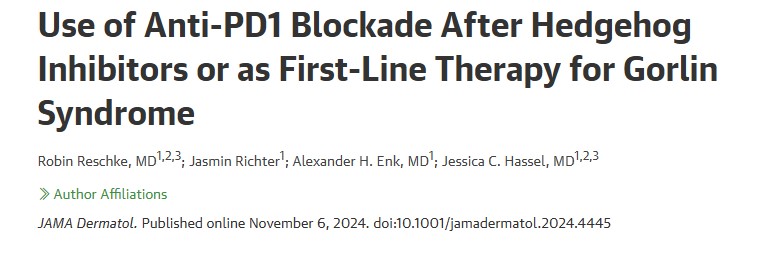
Use of Anti-PD1 Blockade After Hedgehog Inhibitors or as First-Line Therapy for Gorlin Syndrome
Dr. Robin Reschke and Prof. Jessica Hassel and colleagues from the National Center for Tumor disease in Heidelberg published exciting results for patients with Gorlin Syndrome.
Gorlin Syndrome, a genetic condition, often results in numerous basal cell carcinomas (BCCs). One patient in the study had developed over 200 BCCs before starting systemic treatment.
Hedgehog inhibitors can help control BCC growth but may lead to adverse effects and resistance, necessitating alternative therapies.
Anti-PD1 therapy stands out as a potential option for Gorlin Syndrome patients, utilizing immune pathways to target emerging BCCs. Notably, T cell infiltration and PD-L1 expression in a responsive case may shed light on underlying mechanisms, providing valuable insights for future treatment.
Read the full article at JAMA Dermatology Medical Journal.

Dr. Robin Reschke, physician scientist and Max-Eder Junior Research Group Leader at the National Center for Tumor Diseases (NCT) Heidelberg, recently shared on Linkedin:
” I’m thrilled to share our latest research letter: “Use of Anti-PD1 Blockade After Hedgehog Inhibitors or as First-Line Therapy for Gorlin Syndrome.”
Gorlin Syndrome is a rare genetic disorder characterized by the development of numerous basal cell carcinomas (BCCs). In our cohort, one patient presented with a very extensive history of over 200 BCCs prior to initiating systemic therapy. Although hedgehog inhibitors have proven effective in managing BCCs, toxicity and resistance can result in discontinuation.
Implications: Anti-PD1 therapy emerges as a viable alternative for patients with Gorlin Syndrome. This approach leverages the immune system to combat new BCC occurrences, offering hope for better management of this challenging condition. Observation of T cell infiltration and PD-L1 expression in responsive patients, highlighting potential mechanistic insights.”
-
Challenging the Status Quo in Colorectal Cancer 2024
December 6-8, 2024
-
ESMO 2024 Congress
September 13-17, 2024
-
ASCO Annual Meeting
May 30 - June 4, 2024
-
Yvonne Award 2024
May 31, 2024
-
OncoThon 2024, Online
Feb. 15, 2024
-
Global Summit on War & Cancer 2023, Online
Dec. 14-16, 2023
